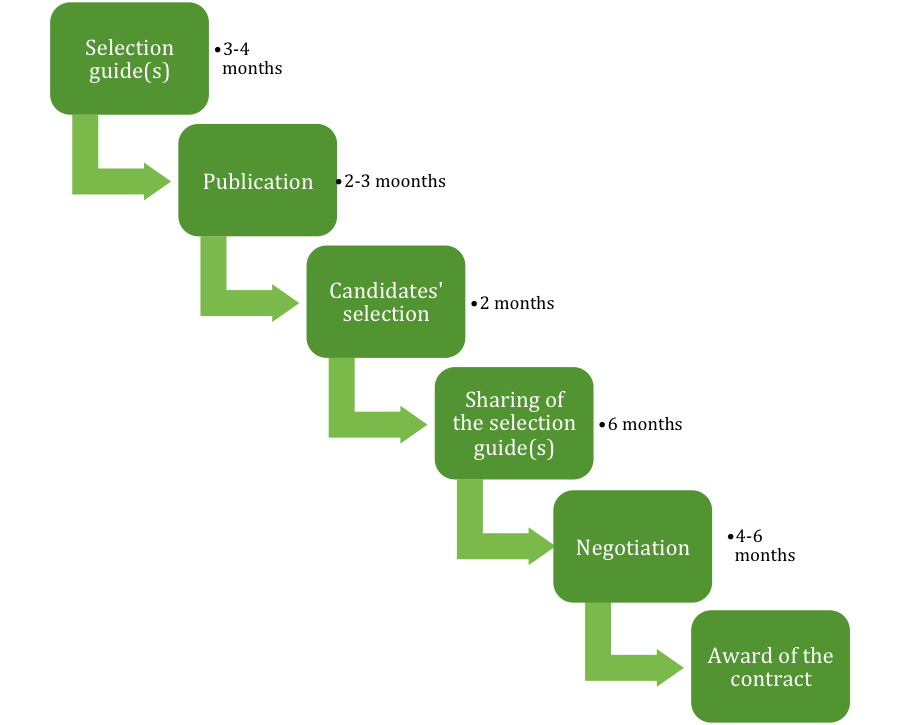Tendering
The set-up of a “framework” (either a central purchasing agency or a procurement agency) at the very beginning of the One Stop Shop is a prerequisite for the launch of the tendering process. For further details on it, see section 6.5. Set-up of a central purchasing agency or a procurement agency (p.15-19).
The chart below shows the different steps of the tendering process put in place by the One Stop Shop, from the draft of the selection guides to the award of the contract. Depending on the scope of the project, the tendering process may last between 17 to 21 months.

Explanation of the chart above
Selection guide(s): draft of the tender documents. It consists of preparing the specifications for each EPC-M (energy performance contracting and monitoring) pool.
Publication: Publication of the tender documents.
Candidate selection: selection based on qualitative and administrative criteria.
Sharing of the selection guide(s): the specification for each pool of buildings is sent to the shortlisted bidders.
Negotiation: the interested bidders make an offer in which they commit to decrease by xxx (to be determined) the energy consumption against a fee of xxx€ (to be determined). The bidders carry out themselves the energy audits of the buildings. The offers are compared.
Award of the contract: Notification and award of contracts (i.e. chose the bidders): a contract is signed by the chosen bidder and the contracting authorities. The One Stop Shop accompanies the contracting authorities during the whole process and advises them on the selection of the bidder, the contract negotiation and its implementation.
The chosen procedure by RenoWatt is the European negotiated procedure with publication, which has the advantage of being quite flexible, fast and not too expensive.
There is also what is called the « Competitive Dialogue » procedure (for further details on the procedure, please click here), which was not appropriate in RenoWatt’s case, since it is a longer and time-consuming procedure, and subsequently it costs money, either for the public tenderer, or the bidders.
For informational purposes, a detailed timeline on the tendering process for the school’s tender can be found in annex 11 (starting from p.54).
Elements to include in the public tenders
Environmental, social and ethical clauses, as well as an access to SMEs. The object of the contract is to reach energy efficient refurbishment with a view to socio-professional reintegration. Fostering local employment is the main mission of the piloting activities in the Liège Region (by GRE Liège).
A clause on giving the priority to new economic models and pushing to change the range of goods and services they offer
Qualitative selection:
- Focus on development in the region
- List of subcontractors once the applications have been received
- Administrative Certificates (adequate payment of all taxes)
Award criteria
- Score for the share of subcontracting with SMEs
- Scores for environmental and social aspects (maintenance plan, recycling, CO², emissions, etc.)
Conditions for implementation
- Limitation of extend of subcontracting
- Social implementation clauses
- Conditions for maintenance
- Reminders on minimum working conditions
Financial validation
See annex 11 of Toolkit: financial plan presentation.
Debt constraints
The states’ debt crisis and the budget constraints (the Walloon Government defines a yearly maximum amount of debt for municipalities, calculated according to the financial health of the municipality and the number of citizens) set up by the government are a barrier to launch ambitious retrofit projects.
Financing is key and a particularly complex aspect at different levels:
- Developing an appropriate financing model, which requires specific competencies, in accordance with the public debt constraint,
- Energy retrofit projects requires important early stage capitals,
- Financing and funding search.
Financing solutions will depend from one Member State to another. It is important to develop the solution together with the competent higher level of government. Eurostat has defined rules and so far, EPCs are very difficult to deconsolidate from the overall state debt.
Working with third party investments or funds (cf. different case studies studied by CITYnvest) is a financing solution. However:
- It is not a deconsolidating solution, whoever finances the project
- It is more expensive than a bank debt (especially for public authorities as it is considered as sovereign debt)
In the context of RenoWatt, it has been decided, together with the Walloon government, not to include energy retrofitting investments in the municipality budget constraint and to finance the retrofit works through simple debt (i.e. Bank loans).


 Print HTML
Print HTML